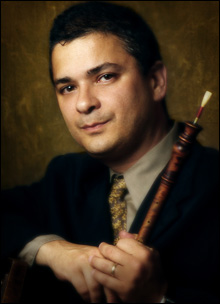
MASTER OF HIS DOMAIN: Gonzalo X. Ruiz lived up to his billing as one of the world's great Baroque-oboists. |
File this one under "Stuff White People Like": an unheralded early-music ensemble made up of oboes and recorders and bassoons (with theorbo/guitar and percussion) comes to town for its world debut and sells out the house. The house in question was Harvard Square's First Congregational Church, so maybe the category should be "Stuff Cambridge White People Like." Or maybe the turnout was just a tribute to the Boston Early Music Festival's track record. There
is a fair bit of boring, academic early-music performance out there, but the folks at BEMF hardly ever find it.
What they found instead for last Friday's presentation was close at hand: Gonzalo X. Ruiz has been a long-time member of the BEMF Orchestra, and now he has his own 10-member band who (as he explained in the program) take their exotic-looking French name, Symphonie des Dragons, "from the custom of different military regiments to field their own such band." That is, "dragons" as in "dragoons." Ruiz continued, "Our line-up mirrors that of the Douze Grands Hautbois, which together with the Vingt Quatre Violons du Roi formed the basis for Lully's legendary orchestra."
No surprise, then, that Symphonie des Dragons' debut program was titled "From the Court to the Stage: The Rise of the French Oboe Band," or that it began with "Marche des combattants" from Jean-Baptiste Lully's 1674 opera Alceste and continued with a suite from that work. In his program note, Ruiz also explained that at Versailles, following the development of the Baroque oboe in the 1660s (its predecessor was the shawm), double-reed ensembles were "ubiquitous, and probably heard more often by more people than what we would call an orchestra." What's more, "Louis XIV rose in the morning to the sound of oboes, and no garden stroll was complete without a band trailing the entourage."
Taking their cue from the Sun King, Symphonie des Dragons processed through the audience to the stage, making a joyful racket as they went, becoming perhaps the 21st century's first oboe marching band. With the exception of theorbo/guitar player Charlie Weaver, around whom they formed a semicircle, they played standing — or, rather, dancing. Ruiz, who was recently appointed to the faculty at the Juilliard School, bobbed and weaved as if he were playing clarinet or sax in a jazz ensemble.
Lully's Alceste draws on the play by Euripides in which Admetos is fated to die and his wife, Alkestis, volunteers to go down to Hades in his place — whereupon Herakles wrestles Death for her and wins. The suite Ruiz and company presented was similar to the one Jordi Savall (with whom Ruiz has performed) and Le Concert des Nations offer on their AliaVox Lully CD, L'orchestre du roi soleil. Symphonie des Dragons were a bit more held back — more "French," perhaps — than Savall's outfit, and Le Concert des Nations conveys a more complete sound picture, but the unalloyed sweet-sour squeal of all those oboes and recorders was hard to resist, and there was ample variety in the different numbers, from the zippy "Loure pour les pêcheurs" to the solemn "Pompe funèbre" for Alceste. Benjamin Harms, who manufactures period percussion instruments, used an æoliophone to bang out the ferocious winds of Hades.